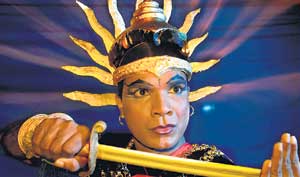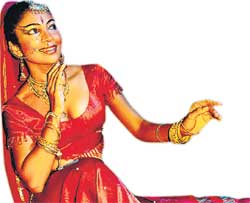
Ravana regainedEvery nation, strives to keep true to an icon; a national figure. The manner in which the icon is portrayed can take many forms. This is the story behind the ballet Maha Ravana.
The Ramayana, an epic, woven around Rama-Ravana and Sita, by Indian poet Valmiki, has always been given the highest recognition and authority in Sri Lanka. But has anyone ever stopped to question the authenticity behind the main story? Does it purely belong to the realm of fantasy and what about the characters? Who was Ravana, the demon king of Sri Lanka? Was he really a 'demon'? The oriental ballet, Maha Ravana seeks to answer these questions. Pabalu Wijegoonewardane, the director says he didn’t want to subscribe to what he calls an imported legend. “I wanted to find out whether Ravana was really a 'demon' and whether everything that we blindly believe in the Ramayana about him is true. This is what led me to trace this legend with a new perspective,” he says adding that Ravana was the only king who managed to wipe out all forms of divisions in Sri Lanka, uniting it. He not only ruled Sri Lanka but governed a vast kingdom with boundaries extending over South Asia. Pabalu says however that in the hands of the Indian poet Valmiki, Ravana underwent a complete transformation and became the demon king as opposed to the gentle Rama. The root of the Maha Ravana ballet, Pabalu says, can be found in the Lankavathara Suthra, said to be preached to Ravana by Konagama Buddha (the Third Buddha in the Maha Bhadra Kalpa Era). Another legend associated with Ravana is his flying machine, the Dandu Monara Yanthra or Pushpaka Vimana, which helped him travel around South Asia. While the concept of a flying vehicle during the time of Ravana seems almost unbelievable, Pabalu says the Vimanika Shasthra by Maha Rishi Bharadvaja has documented evidence of such inventions.
In addition to the controversial nature of Maha Ravana appealing to him, Pabalu says his love for music and dance made him take on the challenge of directing this ballet. In 2004 he directed the dance drama Iris, based on the short story of the same name by Herman Hesse. The ballet will be what he calls a fusion of world music and dance. It is presented by the Sarasavi Dehena Experimental Theatre School. Kumudu Nishantha, a well known television drama actor who plays the lead role of Ravana says the role gives him the opportunity to enact the life of a true king of Sri Lanka. Mihiri Weerarathne, a performing arts graduate from the University of Visual and Performing Arts plays the role of Sita. "The portrayal of Sita is simply magical. I am honoured to be playing such a role and I hope I will be able to do it justice,” she says. Hasantha Hiroshana, a dancer and professional costume designer who is behind the elaborate costumes of the production plays Rama while Pabalu plays Indrajith, the warrior son of Ravana. Maha Ravana: The Rising Sun of a Dying Realm, goes on the boards on May 30, at 6.15 p.m. at the John de Silva Theatre. |
|
||||||
|| Front
Page | News | Editorial | Columns | Sports | Plus | Financial
Times | International | Mirror | TV
Times | Funday
Times || |
| |
Reproduction of articles permitted when used without any alterations to contents and a link to the source page.
|
© Copyright
2008 | Wijeya
Newspapers Ltd.Colombo. Sri Lanka. All Rights Reserved. |

